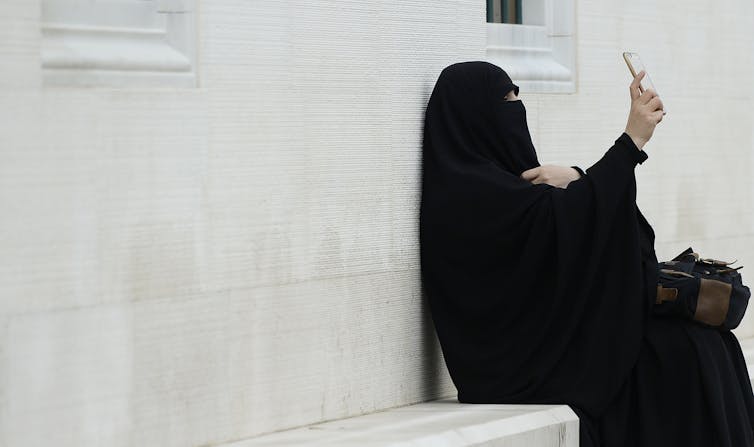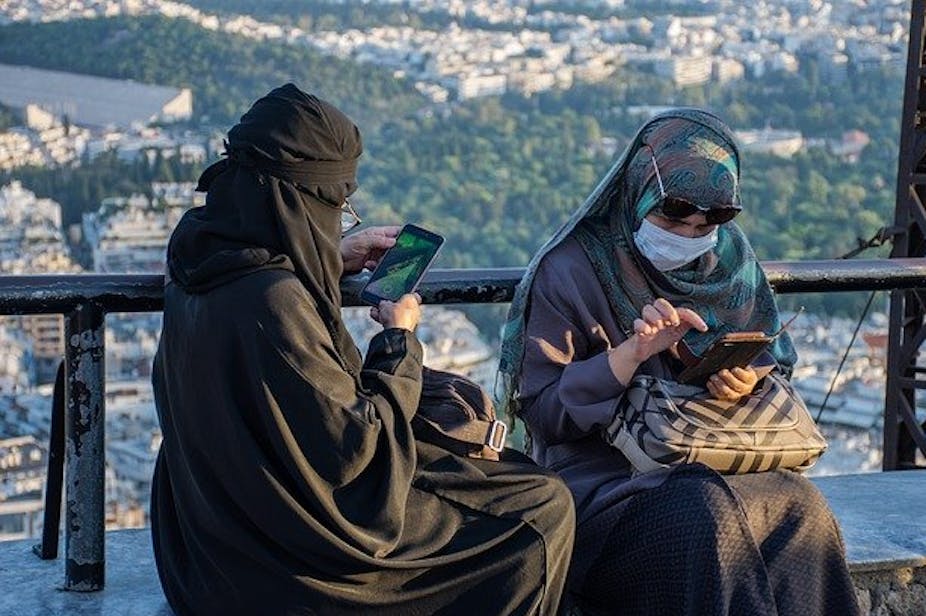One year into the pandemic, protective face masks have come to signify different things for different groups of people.
To some it’s an issue of protest, while for some others it’s a statement of social responsibility. Some people have even turned it into a style statement and are willing to spend hundreds of dollars on designer masks.
At the same time, racialized perceptions related to masks have put an additional burden on groups that already experience racism and inequality. Across the country, several Black American men have been arrested, followed and challenged by police officers who claimed they looked “suspicious” in pandemic masks.
But in a group I have studied since 2013 – Muslim women in the West who wear the niqab, or the Islamic veil, along with a headscarf, the experiences have been more positive.
Challenges faced by many Muslim women
The niqab is worn by a small minority of Muslim women. It is a piece of cloth tied over the headscarf (hijab) that comes in a variety of styles and colors. It is sometimes mistakenly labeled as the burqa, which is an all-enveloping garment that largely entered the American imagination during the U.S.-led invasion of Afghanistan. At that time the Western media, while depicting burqa-clad women, wrote about how the war would help advance the rights of Afghan women.
Niqab wearers are a difficult group to study, and scholars have described them as a “rare and elusive religious sub-culture.” Despite this challenge, I have been able to conduct three research projects that relied on interviews with women who wore the niqab.
Initially, I conducted a larger study of 40 women that I published in my book “Wearing the Niqab: Muslim Women in the UK and the US.” I also interviewed a group of 11 women in April 2020 after mask-wearing became mandated in public in many U.S. states and countries. In January I was able to reach 16 women who agreed to be interviewed about their experiences of wearing the niqab one year into the pandemic.
I found that many recently adopted the niqab because walking around with a covered face became less daunting as more people appeared in public with face masks. As I found, many wanted to wear the niqab to underscore the religious character of this practice.
Some women wore a mask under the niqab, mindful of the health guidance that requires masks to be constructed out of a “tightly woven fabric,” in order to stop the virus from being spread. Others used thick, snugly attached niqabs in lieu of a mask.
Studies have shown that Muslim women more likely to experience prejudice in public spaces, employment and other services, when they dress religiously. Over 80% of the women I interviewed for my book said they experienced some form of abuse in public, such as hostile stares, comments, having the niqab ripped off or being physically injured.
Legislation that bans religious face coverings in public has been passed in some countries and territories, such as France and Quebec. On March 7, Swiss citizens will be voting on a niqab ban in a nationwide referendum. In the past, advocates of such laws have argued that face-covering is a sign of religious extremism, social separation and patriarchal oppression of Muslim women.
However, during the pandemic, criticism has been leveled by scholars and activists at governments that upheld such legislation while simultaneously requiring their citizens to wear masks.
In France, for example, one is liable to pay US$165 (or 135 euros) if caught in public without a mask, while wearing a niqab still carries a risk of being fined up to $180.
During my interviews in April with 11 niqab-wearing women in the United States and Europe about their experiences of face-covering during the early phase of the pandemic, I found their responses to be guardedly positive. Women reported decreased levels of the kinds of prejudice they experienced before the pandemic. They attributed this to the new social expectation that everyone was wearing a facial covering. Many enjoyed the sense of “invisibility” while wearing the niqab.
A woman from Illinois who I spoke with over Zoom (names of the respondents are withheld to preserve their anonymity) said: “There are so few of us, and still we were told we were a threat to society because we covered our faces. Now that argument has just disappeared. I just hope this sentiment doesn’t make a comeback once the pandemic is over.”
Free to dress religiously
Almost a year later, I went back to find out whether the “mask effect” held steady for these women. I spoke with 16 women who said that the niqab had become a much more accepted option among the pandemic masks. I found that many women were switching from wearing it only occasionally outside their homes to every time they were in public spaces. Some actually adopted this garment for the first time in their lives.

In an online poll that I ran with the help of the owner of the online Islamic fashion boutique Qibtiyyah Exclusive UK as part of my 2021 study, 14 women out of 51 who responded said that they had decided to begin wearing the niqab during the pandemic.
One anonymous respondent commented: “I feel this is the perfect opportunity for any Muslimah [Muslim woman] to start wearing the niqab. I would if I didn’t already.” Another wrote: “It’s been a flawless transition [to wearing the niqab]. No one says a word.” Another stated, “I’d been experimenting with the niqab before, but now, since COVID, I have worn the niqab full time.”
[Deep knowledge, daily. Sign up for The Conversation’s newsletter.]
The niqab is not mentioned by the Quran – which mandates only modest clothing for both men and women more generally. The Quran (24:31) says: “And tell the believing women to lower their gaze and guard their chastity, and not to reveal their adornments except what normally appears. Let them draw their veils over their chests, and not reveal their hidden adornments …”
An individual practice
There is a common misconception in the West that this is an oppressive, patriarchal practice forced upon Muslim women. In reality, several studies have shown that many women choose to wear the niqab – sometimes against their families’ preferences.
The 40 niqab wearers I interviewed for my book considered it a religious practice. Many of them said that the wives of Prophet Muhammad reportedly wore it regularly. A woman from Texas said: “I wear the niqab because I choose to follow what I believe to be the most accurate interpretation of God’s word that says women who cover their faces will be rewarded for fulfilling this extra duty.”
It is a highly individual practice to which the women I interviewed came after a long reflection. They acknowledged that while the niqab may be suitable for them, it might not work for others. A woman from the U.K. explained why some women choose to wear it while others don’t: “The Quran says to cover yourself modestly. Now, the interpretation of that is different to every group of Muslims. Some people believe it just to be the loose dress. Others believe it to be an outer garment as well as headscarf. Yet others would go one step further and say it’s the face covering as well, because [the Quran] says to cover yourself.”
Women who adopted the niqab after the beginning of the pandemic also described their experiences to me. Following years of doubt about the safety of wearing the niqab in their neighborhoods, they felt this was the best time to try.
A woman from Pennsylvania who began wearing the niqab in late 2020 sent me a message: “I wanted to wear the niqab for a long time, but I live in a very white area. I was afraid – I don’t like to be stared at and I already get enough of that in my hijab. With everyone wearing a mask, I figured now’s the time. At first, I wanted to only test it out, but literally nobody looked at me twice. So I’m just wearing it, with a mask underneath.”

